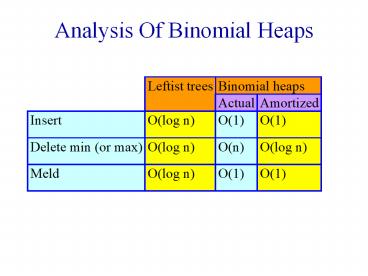Analysis Of Binomial Heaps - PowerPoint PPT Presentation
Title:
Analysis Of Binomial Heaps
Description:
Pairwise combine min trees whose roots have equal degree. ... with the min tree that is created by ... Let u be the degree of min tree whose root is removed. ... – PowerPoint PPT presentation
Number of Views:253
Avg rating:3.0/5.0
Title: Analysis Of Binomial Heaps
1
Analysis Of Binomial Heaps
2
Operations
- Insert
- Add a new min tree to top-level circular list.
- Meld
- Combine two circular lists.
- Delete min
- Pairwise combine min trees whose roots have equal
degree. - O(MaxDegree s), where s is number of min trees
following removal of min element but before
pairwise combining.
3
Binomial Trees
- Bk , k gt 0, is two Bk-1s.
- One of these is a subtree of the other.
4
All Trees In Binomial Heap Are Binomial Trees
- Insert creates a B0.
- Meld does not create new trees.
- Pairwise combine takes two trees of equal degree
and makes one a subtree of the other. - Let n be the number of operations performed.
- Number of inserts is at most n.
- No binomial tree has more than n elements.
- MaxDegree lt log2n.
- Complexity of remove min is O(log n s) O(n).
5
Aggregate Method
- Get a good bound on the cost of every sequence of
operations and divide by the number of
operations. - Results in same amortized cost for each
operation, regardless of operation type. - Cant use this method, because we want to show a
different amortized cost for remove mins than for
inserts and melds.
6
Aggregate Method Alternative
- Get a good bound on the cost of every sequence of
delete mins and divide by the number of delete
mins. - Consider the sequence insert, insert, , insert,
delete min. - The cost of the delete min is O(n), where n is
the number of operations in the sequence. - So, amortized cost of a delete min is O(n/1)
O(n).
7
Accounting Method
- Guess the amortized cost.
- Insert gt 2.
- Meld gt 1.
- Delete min gt 3log2n.
- Show that P(i) P(0) gt 0 for all i.
8
Potential Function
- P(i) amortizedCost(i) actualCost(i) P(i
1) - P(i) P(0) is the amount by which the first i
operations have been over charged. - We shall use a credit scheme to show P(i) P(0)
gt 0 for all i. - P(i) number of credits after operation i.
- Initially number of credits is 0.
- P(0) 0.
9
Insert
- Guessed amortized cost 2.
- Use 1 unit to pay for the actual cost of the
insert. - Keep the remaining 1 unit as a credit for a
future delete min operation. - Keep this credit with the min tree that is
created by the insert operation. - Potential increases by 1, because there is an
overcharge of 1.
10
Meld
- Guessed amortized cost 1.
- Use 1 unit to pay for the actual cost of the
meld. - Potential is unchanged, because actual and
amortized costs are the same.
11
Delete Min
- Let MinTrees be the set of min trees in the
binomial heap just before delete min. - Let u be the degree of min tree whose root is
removed. - Let s be the number of min trees in binomial heap
just before pairwise combining. - s MinTrees u 1
- Actual cost of delete min is lt MaxDegree s
- lt 2log2n 1 MinTrees.
12
Delete Min
- Guessed amortized cost 3log2n.
- Actual cost lt 2log2n 1 MinTrees.
- Allocation of amortized cost.
- Use 2log2n 1 to pay part of actual cost.
- Keep remaining log2n 1 as a credit to pay part
of the actual cost of a future delete min
operation. - Put 1 unit of credit on each of the at most log2n
1 min trees left behind by the delete min
operation. - Discard the remaining credits (if any).
13
Paying Actual Cost Of A Delete Min
- Actual cost lt 2log2n 1 MinTrees
- How is it paid for?
- 2log2n 1 comes from amortized cost of this
delete min operation. - MinTrees comes from the min trees themselves, at
the rate of 1 unit per min tree. - Potential remains nonnegative, because there are
enough credits to pay the balance of the actual
cost.
14
Potential Method
- Guess a suitable potential function for which
P(i) P(0) gt 0 for all i. - Derive amortized cost of ith operation using DP
P(i) P(i 1) - amortized cost actual cost
- amortized cost actual cost DP
15
Potential Function
- P(i) SMinTrees(j)
- MinTrees(j) is MinTrees for binomial heap j.
- When binomial heaps A and B are melded, A and B
are no longer included in the sum. - P(0) 0
- P(i) gt 0 for all i.
- ith operation is an insert.
- Actual cost of insert 1
- DP P(i) P(i 1) 1
- Amortized cost of insert actual cost DP
- 2
16
ith Operation Is A Meld
- Actual cost of meld 1
- P(i) SMinTrees(j)
- DP P(i) P(i 1) 0
- Amortized cost of meld actual cost DP
- 1
17
ith Operation Is A Delete Min
- old gt value just before the delete min
- new gt value just after the delete min.
- MinTreesold(j) gt value of MinTrees in jth
binomial heap just before this delete min. - Assume delete min is done in kth binomial heap.
18
ith Operation Is A Delete Min
- Actual cost of delete min from binomial heap k
- lt 2log2n 1 MinTreesold(k)
- DP P(i) P(i 1)
- SMinTreesnew(j) MinTreesold(j)
- MinTreesnew(k) MinTreesold(k).
- Amortized cost of delete min actual cost DP
- lt 2log2n 1 MinTreesnew (k)
- lt 3log2n.






























